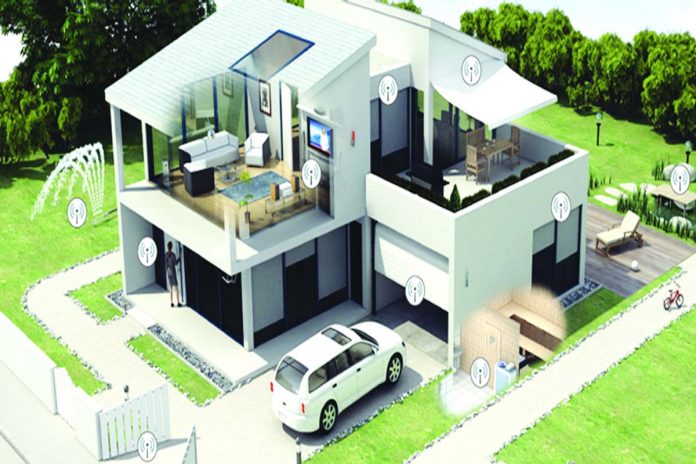Y Udaya Chandar
Home automation is the process of building automated systems for a home; the result is known as a ‘smart home’ or ‘smart house’. Home automation systems can control lighting, climate, entertainment systems and appliances. They may also include security services, such as access control and alarm systems. The user interfaces for controlling these systems are typically wall-mounted terminals, a tablet or desktop computer, a mobile phone application or a web interface. These may also be accessible off-site via the Internet.
India’s adoption of wireless technologies for connectivity has boosted the home automation market, unleashing a number of trends and the proliferation of new technologies.
Many wireless technologies are used in home automation systems, including Bluetooth, Wi-Fi, ZigBee and, in the Indian market, Z-Wave. Companies weigh trade-offs against application requirements that define parameters such as range, power consumption, reliability, data rate, security and addressing.
Data science and machine learning techniques are applied to user data to derive information, such as predictive behaviours, that leads to the development of differentiated services and new revenue streams. At present, this multifaceted issue is focussed on cloud-based systems, which have implications for consumer privacy with which many regulators are still grappling.
Cloud-based services and general purpose controllers are also driving the market. The cloud is a convenient site for storage, computing and networking and has helped to reduce the cost of end-user devices and ease the introduction of new services. The integration of these cloud services is bringing dramatic changes to the home automation sector.
New inventions and discoveries have entirely changed our way of life. They have minimised the effort required in every aspect of life, reducing our need to engage in physical work. This is how the ‘Internet of Things’ (IoT) came into being. By definition, IoT refers to all of the electrical appliances and other devices that interact usingthe Internet. Its seamless user experience has proven beneficial in home, agriculture and healthcare contexts.
The benefits of home automation include:
Elderly and disabled care: Home automation companies enable users to control their homes from a mobile app that is easy for older people to use. This is a viable option for those who prefer to remain in their own homes, safely and comfortably. Smart home products such as sensors and automatic door locks can ensure their safety and independence.
Working parents: Working parents devote a great deal of effort to taking care of their children, but home automation can make their jobs easier. With the help of smart security, parents who are at work can check in on their children and observe their activities online.
Energy Monitoring: Many home automation companies provide energy consumption monitoring devices to help consumers keep track of their use of electricity.
Now, more than ever, less physical effort is required after coming home from a hard day’s work. Home automation companies are creating solutions that are both intelligent and intuitive.
In recent years, the home automation market has been in a phase of rapid change; this has paralleled the advancement of smartphones and wireless data service. It has since accelerated the breaking down of boundaries long maintained by established technology players, as new entrants challenge traditional approaches with new business models, technologies and applications. Without a doubt, the home automation market will remain a focal point in India within the greater IoT market space.
We think home automation has a great future in India.
* By 2022, the Indian home automation industry will be worth Rs. 30,000 Cr.
* India is home to a huge construction industry. In a city like Mumbai, where construction never stops, home automation is catching up very fast.
* Home automation companies are focusing on robust product development.
* This will generate a lot of future for home automation. It will also create a lot of ‘big data’, which will be consumed by taking consumer patterns and designing bespoke requirements for a city, ward or house.
* We will all soon be living in an assisted environment. Like augmented reality, we will soon enter ‘assisted reality’, which will have the effect of reducing our need to complete mundane tasks. Devices such as Google Home and Amazon’s Alexa are the latest voice-controlled devices making home automation more attractive than ever.
* The availability of automated systems that can be operated over high-speed Wi-Fi with a powerful smartphone is ubiquitous, and the growing popularity of Internet-connectable gadgets is driving market growth. Moreover, reduced energy consumption and the availability of a broad range of products is anticipated to boost the home automation market in the years to come.
* India is a prospering nation with an annual growth rate exceeding 7 percent There is an ever-increasing income rate among at least the upper half of all wager-earners, and the consumerism bug has bitten the Indians. Now, in the large cities, a 3 BHK flat costs an average of Rs 1.5 Crore, and one can expect to spend an additional Rs 20 lakh on furnishings. New home buyers will not mind spending a few more lakhs to make theirs a smart home.
Home automation has come to stay and grow in India.


